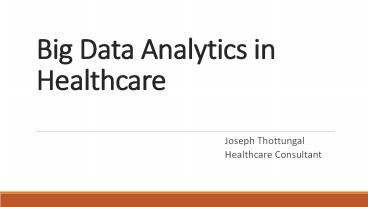Big data analytics in Healthcare - PowerPoint PPT Presentation
Title:
Big data analytics in Healthcare
Description:
This presentation is intended to provide an introduction to Big data analytics in Healthcare; where it stands today and where it is heading to. – PowerPoint PPT presentation
Number of Views:13978
Title: Big data analytics in Healthcare
1
Big Data Analytics in Healthcare
- Joseph Thottungal
- Healthcare Consultant
2
What is Big data?
- Big data means different things for different
industries. The definition also differs within an
organization, across departments and management
layers within IT and business. - At The Big Data Institute (TBDI), big data is a
term applied to voluminous data objects that are
variety in nature structured, unstructured or a
semi-structured, including sources internal or
external to an organization, and generated at a
high degree of velocity with an uncertainty
pattern, that does not fit neatly into
traditional, structured, relational data stores
and requires strong sophisticated information
ecosystem with high performance computing
platform and analytical capabilities to capture,
process, transform, discover and derive business
insights and value within a reasonable elapsed
time.
3
Why Big data analytics in Healthcare?
- Healthcare Industry generates a huge amount of
data such as - Clinical data from CPOE
- Clinical decision support systems such as
physicians written notes and prescriptions,
medical imaging, laboratory, pharmacy, insurance - Patient data in electronic health records (EHRs)
- Claims data
- Machine generated/sensor data, such as from
monitoring vital signs - Social media posts, including Twitter feeds,
status updates on Facebook and other platforms - Data maintained for regulatory compliance such as
Affordable Care Act, HIE, ACO etc.
4
Why Big data analytics in Healthcare?
- Reports say data from the U.S. healthcare system
alone reached, in 2011, 150 Exabytes - At this rate of growth, big data for U.S.
healthcare will soon reach the zettabyte (1021
gigabytes) scale and, not long after, the
yottabyte (1024 gigabytes) - Industry has faced with unsustainable costs and
enormous amounts of under-utilized data, health
care needs more efficient practices, research,
and tools to harness the full benefits of the big
data
5
Challenges
- Healthcare Industry is facing several challenges
in order to leverage potential benefits of Data
analytics - Underinvested due to uncertain ROI
- Many players data sharing is cumbersome.
Accurate analytics are driven by integrating
disparate sets of information, such as clinical,
financial and operational data - Data in silos due to lack of procedures to
integration - Resistance to change - Providers are used to
making treatment decisions based on their
clinical judgment instead of relying on the
protocols based on big data analytics - Patient privacy and security
6
Opportunities
- Big data analytics has potential for benefit for
everyone in the value chain Provider, Payer and
the Patient - Optimizing Care by Device/remote monitoring
- Clinical efficiency, quality, and outcomes by
Patient profile analytics - Disease Identification and Risk Stratification
- Supporting participatory healthcare Public health
analytics - Reducing the Cost of Care by Genomic analytics
- Reducing Hospital Readmissions by Evidence-based
medicine - Reducing Fraud by Pre-adjudication fraud analysis
7
Trends
- Few healthcare players are already started taking
advantage of the potential of big data analytics - Kaiser Permanente has fully implemented a new
computer system, HealthConnect, to ensure data
exchange across all medical facilities and
promote the use of electronic health records. The
integrated system has improved outcomes in
cardiovascular disease and achieved an estimated
1 billion in savings from reduced office visits
and lab tests. - Blue Shield of California, in partnership with
NantHealth, is improving health-care delivery and
patient outcomes by developing an integrated
technology system that will allow doctors,
hospitals, and health plans to deliver
evidence-based care that is more coordinated and
personalized. This will help improve performance
in a number of areas, including prevention and
care coordination.
8
Trends
- AstraZeneca established a four-year partnership
with WellPoints data and analytics subsidiary,
HealthCore, to conduct real-world studies to
determine the most effective and economical
treatments for some chronic illnesses and common
diseases. AstraZeneca will use HealthCore data,
together with its own clinical-trial data, to
guide RD investment decisions. The company is
also in talks with payers about providing
coverage for drugs already on the market, again
using HealthCore data as evidence
9
Whats next?
- Every healthcare player want to use the big data
analytics to gain insights of the data from
various sources to contribute to the following
immediate goals of the industry - Increasing provider and payer efficiencies,
reducing errors and costs - Enabling comparative effectiveness research for
current treatments and to inform RD - Moving toward patient-centered, outcome-oriented
medicine - Empowering consumers - Health 2.0,
participatory healthcare - Making personalized medicine possible for
everyone
Be the first to comment on this presentation.































